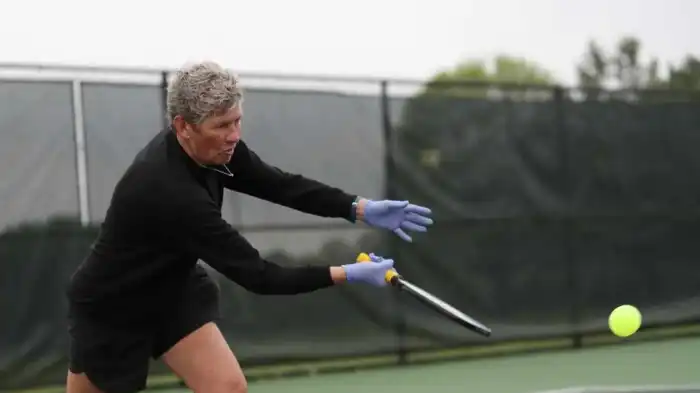Pickleball is a unique and exciting sport that combines elements of tennis, badminton, and table tennis. One of the most important aspects of the game is the serve, which sets the tone for each point. While a variety of serves are employed in pickleball, players often wonder if they can utilize a drop serve as an effective technique. In this article, we will explore the concept of Can You Drop Serve in Pickleball? And examine its advantages and disadvantages.
What is a Drop Serve?
A drop serve, also known as a soft serve or a dink serve, is a type of serve that involves intentionally hitting the ball with spin and minimal power, causing it to drop just over the net. This serve is primarily used as a defensive strategy to limit the opponent’s ability to hit a strong return shot. Can You Drop Serve in Pickleball? By utilizing a drop serve, players aim to force their opponents to hit upward shots, which can limit their power and control.

The Advantages of Drop Serving
Drop serving in pickleball offers several advantages worth considering. Let’s delve into some of the key benefits:
1. Control and Placement
One of the main advantages of drop serving is the ability to control and place the ball with precision. By employing a soft touch and well-executed spin, players can make it challenging for their opponents to handle the serve effectively. A well-placed drop serve also helps enhance the server’s positioning on the court, providing them with a strategic advantage during the rally.
2. Disrupting Opponent’s Rhythm
Drop serves are excellent for disrupting the rhythm and momentum of the opponent. When executed properly, these serves force the opponent to adjust their positioning and shot selection, potentially leading to mistakes or weak returns. By introducing variation in the serves, players can keep their opponents guessing and uncomfortable, gaining an edge in the game.
3. Lower Risk of Error
Compared to traditional power serves, drop serves have a lower risk of error. By focusing on control and finesse rather than power, players minimize the chance of hitting the ball out of bounds or into the net. This reduced risk allows for a higher consistency rate, putting the server in a favorable position to maintain control over the point.
The Disadvantages of Drop Serving
While drop serving can be an effective technique, it does come with some drawbacks that players should be aware of:
1. Limited Power
The main disadvantage of drop serving is its limited power. Since the goal is to land the ball softly just over the net, players sacrifice the potential speed and aggressiveness of the serve. This can provide the opponent with an opportunity to take control of the point more easily, especially if they are skilled at attacking softer shots.
2. Predictability
If a player becomes overly reliant on drop serves, they can become predictable and easier to read. Skilled opponents may anticipate the drop serve and position themselves accordingly, preparing to attack or counter the shot effectively. To prevent predictability, it is important to mix up serves throughout the game and utilize drop serves as a variation rather than the sole serving strategy.

3. Vulnerability to Aggressive Returns
Due to the softer nature of drop serves, opponents who are skilled at aggressive shots may capitalize on this weakness and hit powerful returns. Strong players with good reflexes and footwork can quickly move to the net and put immense pressure on the server, potentially leading to difficult rallies. It is crucial to be prepared for aggressive returns and have a solid defensive plan in place.
Conclusion
Can You Drop Serve in Pickleball? While drop serving can be a valuable tool in pickleball, its effectiveness largely depends on the player’s skill level and the specific game situation. The advantages of control, disruption, and reduced error risk make it an attractive option for many players.
However, it is essential to be mindful of the limited power, predictability, and vulnerability to aggressive returns associated with this serve. By incorporating drop serves strategically and balancing them with other serving techniques, players can improve their overall game and keep their opponents on their toes.
Frequently Asked Questions
Yes, the drop serve technique is allowed in pickleball. It involves intentionally hitting the ball softly and dropping it over the net, placing it in an advantageous position for your opponent to return.
A drop serve can be beneficial as it reduces the power and pace of the serve, making it harder for your opponent to return with force. By dropping the ball close to the net, you can initiate a shorter rally, potentially gaining an advantage in the game.
When using a drop serve, you must ensure that the ball clears the net and lands within the service court diagonally opposite to your position. Additionally, you must avoid touching the non-volley zone (kitchen) when serving.
Yes, the drop serve is suitable for players of all skill levels. Whether you are a beginner who wants to start with a more controlled serve or an advanced player looking for variation in your game, the drop serve can be an excellent technique to include in your repertoire.
While the drop serve can be an effective strategy, there are a few risks involved. The softer pace of the serve might allow your opponent to easily attack and potentially gain an advantage. It’s essential to practice and master the drop serve to ensure better control and accuracy, minimizing the risks.

